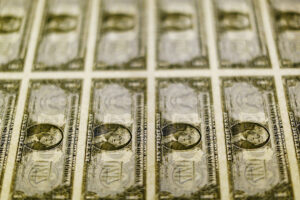




Policy Rate Updates: Double cut finale
 DOWNLOAD
DOWNLOAD

Monthly Economic Update: One for the road
 DOWNLOAD
DOWNLOAD

Inflation Update: Still low, still slow
 DOWNLOAD
DOWNLOAD


Dollar reserves slip to USD99.8B as of end-Aug.

The Philippines’ dollar reserves dipped as of end-August, as the National Government (NG) paid some of its foreign debt obligations and the value of the central bank’s gold holdings fell.
Data released by the Bangko Sentral ng Pilipinas (BSP) on Thursday showed gross international reserves (GIR) slipped by 0.14% to USD 99.81 billion as of end-August from USD 99.95 billion as of end-July.
This was the lowest dollar reserve level since the USD 99.39 billion seen in June.
However, the GIR was 2.4% higher than USD 97.44 billion as of end-August 2022.
“The month-on-month decrease in the GIR level reflected mainly the NG’s payments of its foreign currency debt obligations and the downward adjustments in the value of BSP’s gold holdings due to the decrease in the price of gold in the international market,” the central bank said.
As of end-August, the dollar reserves were enough to cover 5.9 times the country’s short-term external debt based on original maturity and 4.1 times based on residual maturity.
It is also equivalent to 7.4 months’ worth of imports of goods and payments of services and primary income.
Ample foreign exchange buffers protect the country from market volatility and serve as a guarantee for the economy’s ability to pay its debts in the event of an economic downturn.
“The slight decrease in the GIR in August 2023 was due to a number of factors, including the payment of maturing foreign currency obligations, some ‘hot money’ outflows, and the decline in the value of the Philippine peso against the US dollar, among others,” Security Bank Corp. Chief Economist Robert Dan J. Roces said.
Based on BSP data, foreign currency deposits fell by 52.5% to $648 million at end-August from USD 1.367 billion a month earlier and by 63.5% from USD 1.777 billion a year ago.
Rizal Commercial Banking Corp. Chief Economist Michael L. Ricafort attributed the decrease in foreign currency holdings “partly due to some foreign exchange operations (possible foreign exchange intervention activities, as an option signaled by local monetary authorities during the month).”
The peso closed at PHP 56.595 on Aug. 31, depreciating by 3% or P1.715 from the PHP 54.88 finish on July 31.
Meanwhile, buffers in the form of gold were valued at USD 10.23 billion as of end-August, slipping by 0.7% from USD 10.3 billion as of end-July. However, it was up by 19.9% from USD 8.53 billion a year earlier.
The decline in foreign currency deposits and gold buffers were offset by an increase in foreign investments, Mr. Ricafort said.
The BSP’s foreign investments rose by 0.7% to USD 84.33 billion as of end-August from USD 83.68 billion a month earlier. This was also 1.9% higher than USD 82.73 billion a year earlier.
According to the BSP, net international reserves slipped by 0.1% to USD 99.8 billion as of end-August from USD 99.9 billion from end-July.
Net international reserves are the difference between the BSP’s reserve assets (GIR) and reserve liabilities such as short-term foreign debt, and credit and loans from the International Monetary Fund (IMF).
The Philippines’ reserve position in the IMF also declined by 1.4% to USD 790.4 million from USD 801.9 million in July but rose by 6.7% from USD 740.8 million as of end-August 2022.
Special drawing rights (SDRs) — the amount the country can tap from the IMF — inched up by 0.5% to USD 3.81 billion as of end-August from USD 3.79 billion in the month prior. This was 4% higher than USD 3.66 billion a year earlier.
China Banking Corp. Chief Economist Domini S. Velasquez said the country’s GIR as of end-August remains sufficient in terms of its imports and external debt cover.
“We think there is a risk that the GIR will fall in September due to the depreciation pressure on the peso. Moreover, we will likely see higher imports as oil prices continue to climb. This will squeeze the import cover ratio of the GIR,” she said.
The local currency closed at PHP 56.79 versus the dollar on Thursday, strengthening by 15 centavos from its previous finish of PHP 56.94, data from the Bankers Association of the Philippines’ website showed.
Year to date, the peso depreciated by 1.8% or PHP 1.035 from its PHP 55.755 finish on Dec. 29, 2022.
Meanwhile, Mr. Roces said the slight decrease in August GIR is not a “cause for alarm.”
“The outlook for the country’s dollar reserves in the coming months is positive with remittances from BPOs (business process outsourcing) and OFWs (overseas Filipino workers) incoming,” Mr. Roces said.
The BSP is expecting to end the year with USD 100 billion in dollar reserves and $102 billion by end-2024. — Keisha B. Ta-asan
This article originally appeared on bworldonline.com





 By BusinessWorld
By BusinessWorld